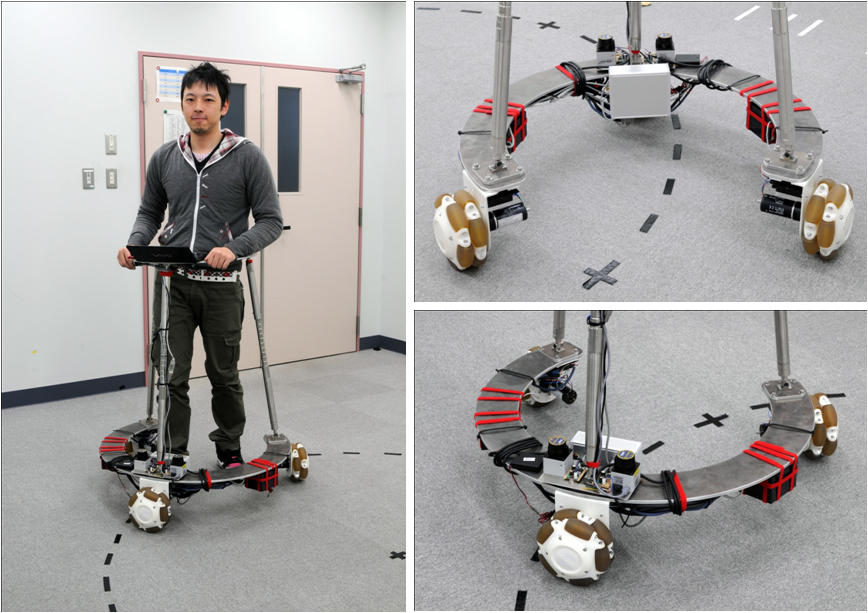Robotics Laboratory
Walfare Robot Team
Research on development of an active walker with easy maneuverability
Introduction
We are currently experiencing severe population aging and facing elderly healthcare challenges. The shortage of trained caregiving professionals often forces people neither well prepared nor confident to give care. Among the problems associated with equipment as well as personnel, physical mobility is the most important ability that helps keep the elderly independent. Recent advances in robot technology have made it possible to design a wide variety of mobility aids. Along these lines, the JAIST Robotics Laboratory is developing a new robotic walker for the elderly and/or lower limb disabled that features an easy-to-use, natural user interface system as shown in Fig. 1. Recent progresses have provided a solid foundation for the development of various walking aids. Notable examples include robotic wheelchair, robotic cane, powered exoskeleton, and robotic walker. These mobility assistive devices could provide users with a certain level of ambulatory capability toward independent living. However, there remains further progress to be made to facilitate widespread use of such devices by enhancing the usability of the user interface. Especially, there are crucial points to take into consideration when developing a walking aid for the elderly. A major premise is that the elderly are slow in behavior and not familiar with mechanical or electronic controls. Moreover, they want to be able to continuously use their own device in daily routines. For instance, they need to use the elevator or bathroom, and navigate in a narrow, crowded hallway. The JARoW prototype is developed to provide potential users with sufficient ambulatory capability in all directions and easy-to-use features. What is the most important aspect from the practical point of view is to develop an active yet compact system not requiring any artificial controls. There is always a challenge on how to design a natural user interface. For the purpose, we employ a pair of laser range finders to detect the user’s lower limbs, and apply an edge detection algorithm to estimate the location of the limbs in real time. The feedback control can then adjust the motions of JARoW corresponding to the user’s walking behaviors, and allow the user to walk naturally. Also, a proximity detection and collision avoidance safety scheme is implemented employing the potential field technique.

Video Clip
Reference List(as of November 2011)
- Takanori Ohnuma, Geunho Lee, and Nak Young Chong. “Particle filter based feedback control of JAIST active robotic walker”, Proc. 20th IEEE International Symposium on Robot and Human Interactive Communication, pp.264-269, August 1, 2011.
- Geunho Lee, Eui-Jung Jung, Takanori Ohnuma, Nak Young Chong, and Byung-Ju Yi. “JAIST robotic walker control based on a two-layered Kalman filter”, Proc. IEEE International Conference on Robotics and Automation, pp.3682-3687, May 11, 2011.
- 大沼 孝徳,鄭 意程, 李 根浩, 丁 洛榮. “カルマンフィルタを用いた歩行支援機JARoW の制御”, 第28回日本ロボット学会学術講演会, September 22, 2010
- 大沼 孝徳,李 根浩, 丁 洛榮. “建設現場における作業員付随ロボットの開発”, 第12回建設ロボットシンポジウム, pp.129-134, September 7, 2010
- Geunho Lee, Takanori Ohnuma, and Nak Young Chong. “Design and control of JAIST active robotic walker”, Journal of Intelligent Service Robotics, vol.3, no.3, pp.125-135, July 1, 2010
- 大沼 孝徳,李 根浩, 丁 洛榮. “操縦装置を持たないアクティブ型歩行支援機JARoWの開発”,ロボティクス・メカトロニクス講演会, June 13, 2010
- Takema Ootubo, Geunho Lee, Takanori Ohnuma, and Nak Young Chong. “A particle filter based lower limb tracking for active walker control”, Proc. International Symposium on Robotics and Intelligent Sensors, pp.168-173, March 8, 2010
- 大沼 孝徳,李 根浩, 丁 洛榮. “ロバストPID制御を用いた歩行支援機JARoWの制御”, 第12回計測自動制御学会システムインテグレーション部門講演会, December 25, 2011